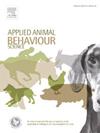什么是强化?释放缰绳张力的时机和马匹从小跑到步行转换时的反应潜伏期
IF 2.2
2区 农林科学
Q1 AGRICULTURE, DAIRY & ANIMAL SCIENCE
引用次数: 0
摘要
缰绳拉紧的信号通常用于在骑马时与马沟通。根据负强化原理,缰绳上的张力作为信号,激励马改变行为,而缰绳张力的释放强化了正确的行为。本研究的目的是探讨骑手缰绳张力信号的特征和释放的时间是否对缰绳张力的大小、马的反应潜伏期以及马的行为和头部姿势产生影响。九名骑手以交叉设计骑着同样的八匹马,每匹马从小跑到步行有八次转换。测量缰绳张力,并从录像中记录骑手使用减速缰绳信号和释放缰绳的时间,以及步态、行为和头部姿势。使用线性混合模型分析数据发现,在缰绳张力信号期间,与过渡前的trot相比,缰绳张力中值和最小值(p = 0.001)增加。在释放过程中,中位数(p <; =0.001)和最大缰绳张力(p <; 0.0001)与缰绳张力信号期间相比下降。有趣的是,与向下过渡相关的释放时间在车手之间有所不同。在大多数情况下,释放是在向下过渡期间给予的(70% %)。然而,在19% %的试验中,释放是在过渡开始之前,在小跑期间给予的,而在11% %的试验中,释放是在过渡结束后,在步行期间给予的。在转变开始之前释放缰张力与较长的反应潜伏期相关(p <; 0.05)。与第一次试验相比,第5次和第8次试验的最大缰绳张力较低(p = 0.02)。马头运动通常与在场时较低的缰绳张力相关,而张嘴与较高的最大缰绳张力相关。由于缰绳张力作用于马的嘴和/或头/鼻子的敏感结构,因此进一步研究降低缰绳张力的方法将有利于马的福利。在线索的实施方面也有进一步的研究空间,无论是单独的还是共同的,以调查骑手通过缰绳的沟通,以及如何有效地将学习理论应用于各级骑手的实践。本文章由计算机程序翻译,如有差异,请以英文原文为准。
What is reinforced? The timing of the release of rein tension and the horse’s response latency for trot to walk transitions
Rein tension signals are commonly used to communicate with a horse during riding. In accordance with the principles of negative reinforcement, tension on the reins acts as signals and motivates a horse to change behavior, while release of rein tension reinforces the correct behavior. The aim of this study was to investigate if the features of rider rein tension signals and timing of the release have effects on the magnitude of rein tension, horse response latency, as well as horse behavior and head posture, during downward transitions. Nine riders rode the same eight horses in a crossover design, making eight transitions from trot to walk with each horse. Rein tension was measured and from video recordings the timing of the riders’ application of the decelerating rein signal and of the release were registered along with gait, behavior and head posture. Analyzing data using linear mixed models, it was found that median and minimum rein tension (p = 0.001) increased during the rein tension signal, compared to in trot before the transition. During the release median (p < =0.001) and maximum rein tension (p < 0.0001) decreased compared to during the rein tension signal. Interestingly, the timing of the release in relation to the downward transition varied among riders. The release was, in most cases, given ‘during’ the downward transition (70 %). However, in 19 % of the trials, the release was given ‘before’ the transition had begun, during the trot, and in 11 % the release was given ‘after’ the transition had ended, during the walk. Releasing rein tension ‘before’ the transition had begun was associated with longer response latency (p < 0.05). Maximum rein tension was lower at the fifth and eighth trial compared to the first (p = 0.02). Horse head movements were generally associated with lower magnitudes of rein tension when present compared to absent, while open mouth was associated with higher maximum rein tension. Since rein tension acts on the sensitive structures of the horse’s mouth and/or head/nose, further research on ways of reducing rein tension magnitude would benefit equine welfare. There is also room for further research on the implementation of cues, in isolation and together, to investigate riders’ communication via the reins as well as how to effectively implement learning theory into practice for riders on all levels.
求助全文
通过发布文献求助,成功后即可免费获取论文全文。
去求助
来源期刊

Applied Animal Behaviour Science
农林科学-行为科学
CiteScore
4.40
自引率
21.70%
发文量
191
审稿时长
18.1 weeks
期刊介绍:
This journal publishes relevant information on the behaviour of domesticated and utilized animals.
Topics covered include:
-Behaviour of farm, zoo and laboratory animals in relation to animal management and welfare
-Behaviour of companion animals in relation to behavioural problems, for example, in relation to the training of dogs for different purposes, in relation to behavioural problems
-Studies of the behaviour of wild animals when these studies are relevant from an applied perspective, for example in relation to wildlife management, pest management or nature conservation
-Methodological studies within relevant fields
The principal subjects are farm, companion and laboratory animals, including, of course, poultry. The journal also deals with the following animal subjects:
-Those involved in any farming system, e.g. deer, rabbits and fur-bearing animals
-Those in ANY form of confinement, e.g. zoos, safari parks and other forms of display
-Feral animals, and any animal species which impinge on farming operations, e.g. as causes of loss or damage
-Species used for hunting, recreation etc. may also be considered as acceptable subjects in some instances
-Laboratory animals, if the material relates to their behavioural requirements
 求助内容:
求助内容: 应助结果提醒方式:
应助结果提醒方式:


